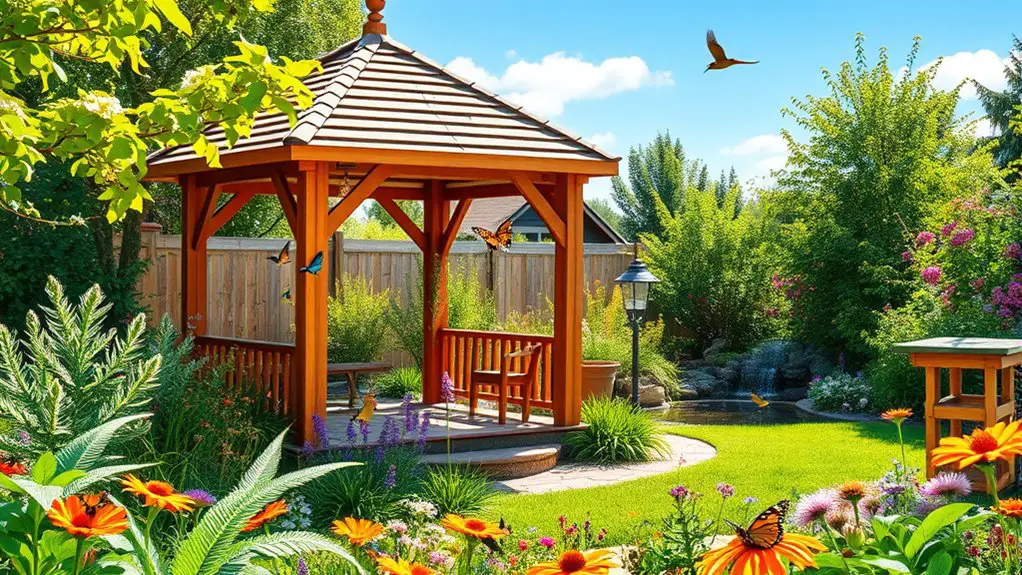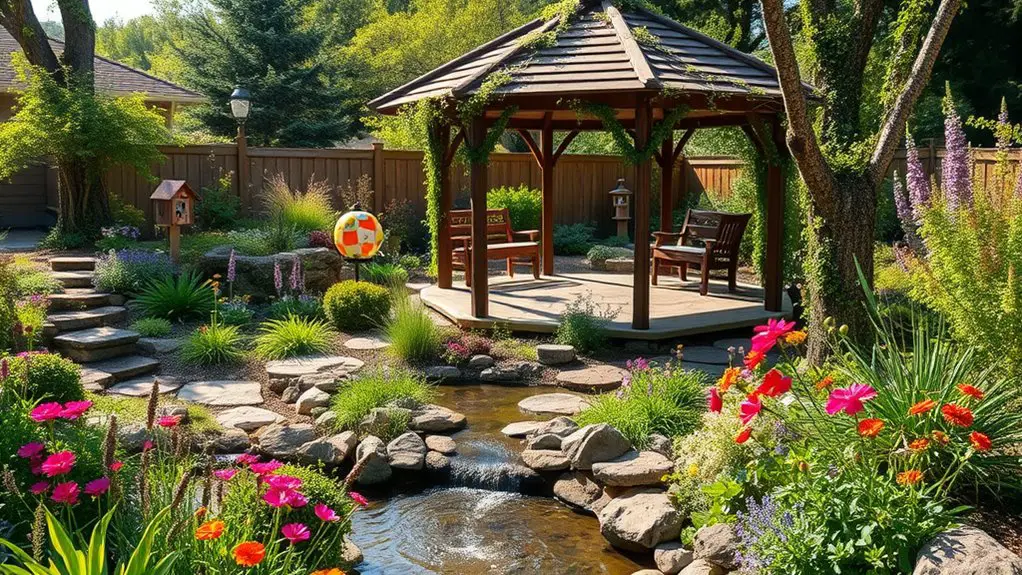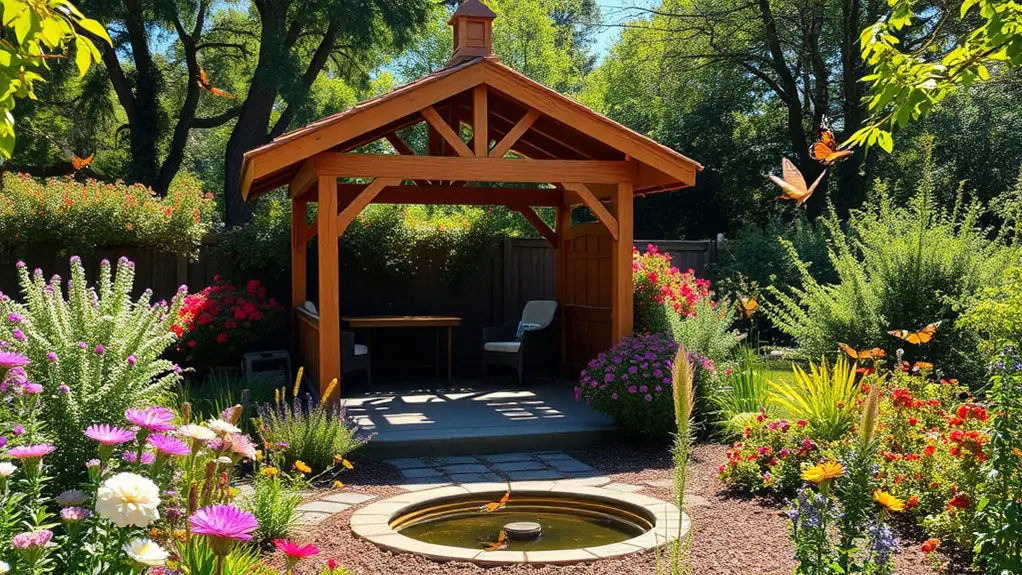To design a backyard gazebo garden that promotes biodiversity, start by evaluating your space and local climate. Choose native plants that support local wildlife and create pollinator pathways. Incorporate features like bird baths and insect hotels to foster habitats for beneficial insects. Opt for sustainable gardening practices, like composting and water conservation methods, to maintain healthy soil. With thoughtful planning, your garden can thrive and attract various species, leading to a vibrant ecosystem just waiting to flourish.
Assessing Your Space and Climate

Before you plunge into designing your backyard gazebo, it is vital to assess your space and climate, as these factors will greatly influence your design choices. Start with a thorough space evaluation; measure dimensions and consider pathways, existing structures, and sunlight exposure. This will help you visualize how your gazebo integrates with the surroundings.
Next, turn your attention to climate considerations. Is your area prone to heavy rains, strong winds, or intense sun? Understanding these elements will guide materials selection—opt for durable, weather-resistant options to promote longevity. You might also think about incorporating features like overhangs or shade structures to protect against the elements. Additionally, consider the orientation of the backyard as it affects sun and wind exposure, which can enhance the comfort of your gazebo.
Choosing Native Plants for Biodiversity
While designing your backyard gazebo, incorporating native plants not only enhances the aesthetic appeal but also supports local biodiversity. By choosing plants that are indigenous to your region, you’ll create sustainable ecosystems that thrive naturally. Consider establishing pollinator gardens filled with native flowers like coneflowers and bee balm, which attract essential pollinators such as bees and butterflies.
Companion planting can also play a crucial role; pairing plants like sunflowers with tomatoes can maximize growth while minimizing pests. These combinations will not only beautify your space but foster a rich habitat for wildlife. Furthermore, native plants generally require less maintenance and water, aligning with sustainable gardening practices. By embracing these strategies, you’re not just decorating your backyard; you’re cultivating a vibrant ecosystem that celebrates freedom in nature’s diversity. Your gazebo garden will become a sanctuary for both you and the wildlife that enriches it. Additionally, incorporating features like built-in grills can enhance outdoor experiences and provide spaces for social gatherings.
Incorporating Water Features and Habitat Structures

Integrating water features like bird baths not only enhances the aesthetic of your gazebo garden but also attracts crucial wildlife. By installing insect hotels, you create indispensable habitats that support pollinators and beneficial insects. These elements foster a thriving ecosystem, promoting biodiversity right in your backyard.
Adding Bird Baths
Incorporating a bird bath into your backyard gazebo garden design can transform your space into a vibrant habitat for local wildlife. A well-placed bird bath attracts various bird species, offering them a revitalizing water source while enhancing the aesthetic appeal of your garden. When choosing bird bath materials, consider options like stone, ceramic, or recycled materials for durability and sustainability.
| Bird Species | Ideal Bird Bath Material |
|---|---|
| American Robin | Ceramic |
| Northern Cardinal | Stone |
| Blue Jay | Recycled materials |
Ensure your bird bath is shallow, with sloped sides for easy access. Regularly clean it to maintain water quality, inviting birds to visit and thrive in your eco-friendly oasis.
Installing Insect Hotels
To create a thriving ecosystem around your backyard gazebo, installing insect hotels can be a game-changer, as they provide essential habitats for beneficial insects like bees and butterflies. These structures attract various insect species, promoting pollination and contributing to biodiversity. When designing your insect hotel, consider using sustainable hotel materials such as:
- Bamboo tubes for solitary bees
- Hollow logs for beetles
- Straw and dried grass for butterflies
- Wood blocks with drilled holes for nesting
- Pine cones for sheltering ladybugs
Designing the Gazebo for Wildlife Interaction
When designing your gazebo, consider incorporating native plants that attract local wildlife, creating a vibrant ecosystem right in your backyard. Incorporating wildlife-friendly features, like birdhouses and pollinator gardens, enhances the interaction between your space and nature. This not only enriches your outdoor experience but also supports biodiversity and sustainability. Additionally, selecting climbing plants for your gazebo can provide natural shade and attract pollinators like bees and butterflies.
Native Plant Selection
While selecting native plants for your gazebo garden, it is important to evaluate how these species will attract and support local wildlife. By incorporating native flora, you not only enhance the beauty of your space but also foster vibrant local ecosystems. Focus on choosing plants that serve as pollinator plants, providing food and habitat for bees, butterflies, and birds.
- Select a variety of flowering plants for continuous blooms.
- Include host plants for caterpillars and larvae.
- Opt for native grasses that offer cover and nesting sites.
- Choose fruit-bearing shrubs to feed birds.
- Consider ground covers to promote soil health and reduce erosion.
Wildlife-Friendly Features
Creating a wildlife-friendly gazebo involves thoughtful design choices that invite nature into your outdoor space. Start by integrating pollinator pathways, using native flowering plants that provide nectar and pollen for bees, butterflies, and other beneficial insects. Position your gazebo near these pathways to enhance habitat connectivity, allowing wildlife to travel seamlessly between food sources and shelter. Consider adding features like birdhouses, insect hotels, and water sources to encourage diverse species to visit. Use natural materials and organic finishes to maintain a healthy ecosystem. By prioritizing these elements, you’ll create a sanctuary that celebrates biodiversity, fosters interaction, and offers you the freedom to connect with nature in your own backyard. Embrace the beauty of coexistence with wildlife!
Implementing Sustainable Gardening Practices

As you begin the journey of designing your backyard gazebo garden, implementing sustainable gardening practices can greatly enhance both the environment and your outdoor experience. By embracing eco-friendly methods, you’ll create a vibrant habitat that supports biodiversity.
Designing a backyard gazebo garden with sustainable practices enriches the environment and fosters biodiversity.
Consider these sustainable gardening practices:
- Composting techniques: Transform kitchen scraps and yard waste into nutrient-rich compost.
- Organic fertilizers: Use natural options to nourish your plants without harmful chemicals.
- Native plants: Select local flora that thrives in your climate and attracts pollinators.
- Water conservation: Implement rain barrels and drip irrigation to minimize water waste.
- Mulching: Apply organic mulch to retain moisture and suppress weeds.
Maintaining Your Gazebo Garden for Long-Term Health
Implementing sustainable gardening practices lays a solid foundation for a thriving gazebo garden, but ongoing maintenance is key to ensuring its long-term health. Start by regularly testing and enriching your soil health with organic compost and natural fertilizers, nurturing a vibrant ecosystem. Seasonal maintenance is essential—prune perennials in early spring, and mulch in the fall to retain moisture while suppressing weeds.
Monitor your plants for pests and diseases, opting for eco-friendly solutions that won’t disrupt your garden’s balance. Embrace companion planting to enhance biodiversity, allowing plants to support each other’s growth naturally. Additionally, ensure you perform regular inspections of your gazebo to identify any damage or wear that could affect the overall environment.
Stay attuned to seasonal changes; adjust your watering schedule and protect sensitive plants during extreme weather. By maintaining this harmonious environment, you’ll not only enjoy a flourishing gazebo garden but also contribute to the larger ecosystem, providing a sanctuary for local wildlife and promoting a sense of freedom in nature.
Frequently Asked Questions
What Are the Best Materials for Building a Gazebo?
Imagine a craftsman shaping timber beneath a rising sun. For your gazebo, consider durable wood types like cedar or redwood, and pair them with sustainable materials like bamboo or recycled steel for a stylish, eco-friendly structure.
How Do I Attract Specific Wildlife to My Gazebo Garden?
To attract specific wildlife to your gazebo garden, incorporate native plants that create diverse wildlife habitats. These plants provide food and shelter, fostering a thriving ecosystem where nature can flourish and you can enjoy its beauty.
Can I Use Non-Native Plants for Certain Areas?
You can use non-native plants in certain areas for their benefits, like attracting specific pollinators. Just make certain they don’t disrupt ecosystem balance; combining native and non-native species can create a vibrant, diverse habitat.
What Tools Are Essential for Maintaining My Gazebo Garden?
To maintain your gazebo garden, you’ll need essential tools like pruning shears for shaping plants and a soil tester to guarantee ideal nutrient levels. These will help create a thriving, sustainable space for your enjoyment.
How Can I Encourage Pollinators in My Garden?
Why not invite buzzing friends into your garden? Plant native plants for their nourishment, and add pollinator hotels for shelter. These simple steps create a vibrant ecosystem, ensuring your garden thrives with life and color.

